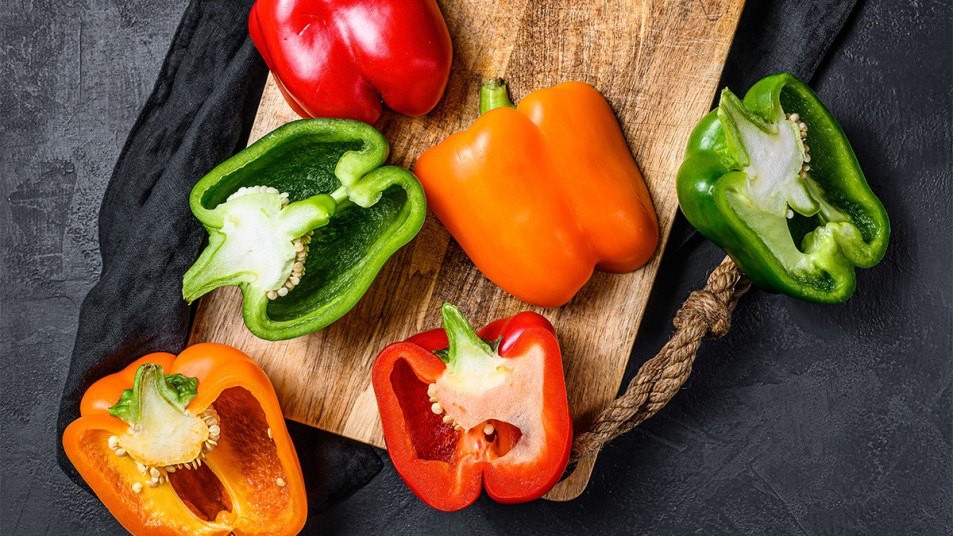We’ve Been Cutting & Storing Bell Peppers All Wrong — Here’s How To Keep Them Crisp
Surprising cutting technique ensures cut bell peppers don't get soggy

Bell peppers are the belle of weeknight dishes such as fajitas, stir-fry and pasta primavera. Along with adding a pop of color, bell peppers infuse dishes with a sweet, mild flavor. A whole pepper can be too much for many dishes, so what’s the best way to store the leftovers?
Most of us just toss bell pepper halves or quarters in plastic baggies and pop them in the fridge. While this is quick and practical, it can actually cause the veggie to become mushy — fast. To the rescue: Keep reading to learn the simple hacks that guarantee your cut bell peppers will stay crisp for twice as long.
The secret way to cut bell peppers that makes the difference
When it comes to bell peppers, uncut whole bell peppers stored in your crisper drawer can stay fresh for up to two weeks. But cut bell peppers? They generally last about two to three days in the fridge tops. Slicing bell peppers shortens its storage life because it causes plant tissue damage and fluid loss to the veggie.
Luckily, there’s a simple way to slow down this process: Cut away only what you need, keeping the stem and seeds attached to any unused pieces of the veggie. Why? Because these parts of the veggie contain key nutrients that maintain its quality and freshness.
The best way to do this is by cutting as much of the veggie as you’ll need at a time. For instance, if you need to cook with half of a bell pepper, slice it completely through the middle and use one portion of it. Then, refrigerate the remaining half with the seeds and stem intact.
You can also slice off two or three sides of the bell pepper, making sure you don’t cut into the core or seeds. Afterwards, you can store the portion you don’t plan on using in the fridge. Watch The Domestic Geek’s video below to learn how to cut bell pepper around the core before slicing or chopping them further.
The best way to store cut bell peppers
Moisture is another factor of cut bell peppers losing their firmness and quality. So in addition to keeping the seeds and stem attached, Nature Fresh Farms suggests storing cut bell peppers in an airtight container with a dry paper towel. The paper towel will absorb any excess moisture, which allows the bell peppers to retain their firmness. Below, you can find four easy steps from Nature Fresh Farms on how to store cut bell peppers for a later use:
- Line an airtight sealed container or plastic bag lined with a paper towel.
- Place bell pepper piece with seeds and stem attached in the container.
- Keep the veggie container in your crisper drawer.
- When you’re ready to use the cut bell peppers, remove them from the container or bag and start cooking.
This food hack saves you money because the cut bell peppers retain their crispness throughout their storage. Because of this, they won’t go to waste and you can use them to whip up mouthwatering dishes such as fajitas and grilled vegetables. Yum!
How to tell if cut bell peppers have gone bad
Bell peppers are known for having a smooth skin, vibrant color and crunchy texture. You’ll know bell peppers, especially ones that are cut, have gone bad if they feel slimy to the touch or, of course, if mold appears on the skin. In this case, the bell peppers should be discarded right away.
Sliced peppers with a wrinkly skin but no mold are fine to consume. However, their loss of crunchiness makes them better for sautéing and roasting than eating raw. Ultimately, storing cut bell peppers correctly reduces their chances of going bad before you’re ready to use them. (Discover how enjoying bell peppers prevents vision-clouding cataracts naturally and helps get rid of a UTI.)
Curious about the other ways you can extend the life of your weekly produce favorites? Check out our stories on a mason jar hack that keeps lettuce fresh for up to a month and a food scientist expert’s ideal method for storing bananas.
















